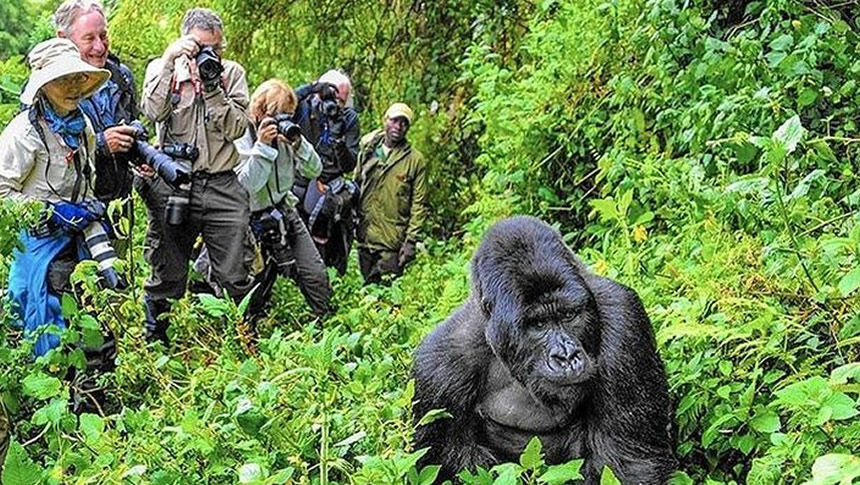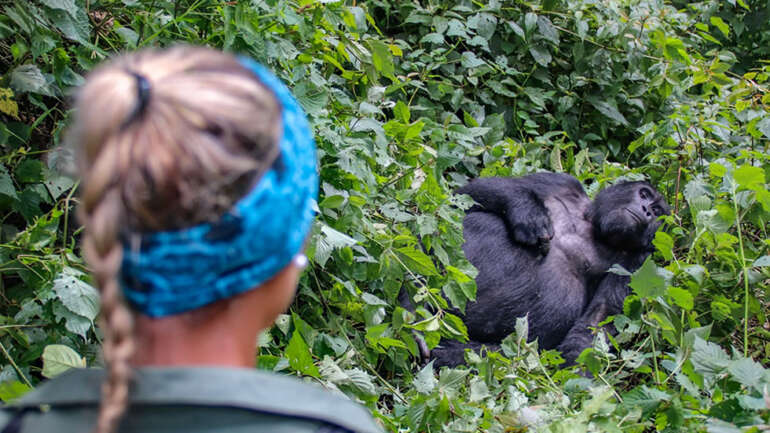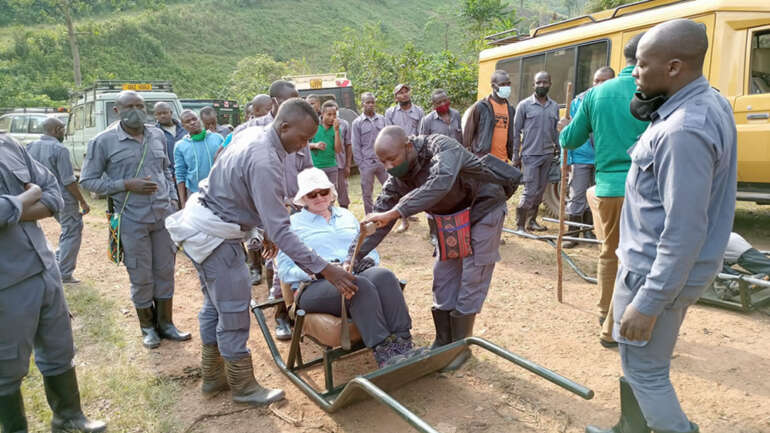The largest living primates, gorillas are widespread residents of the equatorial African rain forest, with a global population of perhaps 150,000-200,000 concentrated mainly in the Congo Basin. Until 2001, all gorillas were assigned to the species gorilla gorilla, split into three races the western lowland gorillas, the eastern lowland gorillas and the mountain gorillas living in highland forest on the eastern side of the Albertine rift.
In general lowland gorillas tend to be smaller having brownish-gray coats and a pronounced brow ridge, while mountain gorillas are large with blacker coats. Mountain gorillas are the rarest primate in the world with fewer than 800 living in the wild. In contrast there are over 100,000 lowland gorillas living in the Republic of Congo alone.
If you have your heart set on seeing the rarer mountain gorillas you are looking at a trip to Uganda or Rwanda plus Congo and here are is what you should consider:
The gorilla trekking system is similar in all three countries, which cooperate in their conservation efforts and devote those high fees, in principle, to monitoring and protecting the species made famous by Dian Fossey’s memoir and in movies like King Kong.
Just eight travelers per day (accompanied by park rangers and trackers) are permitted to hike in search of each gorilla family habituated to human observers. Uganda offers the most permits, with up to 15 habituated gorilla families allotted for tourism (at most, 120 permits would be given out each day); Rwanda, up to ten gorilla families and the DRC with five families. (The number of families accessible to travelers changes each year depending on how governments balance the need for tourist income and the need for research.) To reduce the chance of gorillas catching human diseases, the DRC sometimes limits the size of trekking groups to six people.
Mountain gorillas; Uganda VS Rwanda and Congo in terms of cost
Cost: Gorilla permits in Rwanda have recently (as of 2016) increased to $1500 per person and in Uganda they cost $700 per person while in the low season of April, May and November a permit is at $450per person. The permit gets you an hour of time spent with the great apes with an 8 person group. If you book at the price think of it this way. You are contributing to the preservation of gorillas and as a “thank you” you get to spend an hour with them. Remember only 80 people a day get to see them and their habitat is very fragile.
Ease of Access: Rwanda provides the easiest access to gorilla trekking point. The town of Ruhengeri, the jumping off point for trekking in Volcanoes National Park, is only a few hours’ drive on excellent roads from the capital (and its international airport) Kigali. Seeing gorillas in Uganda is more of a process and involves an 8-10 hour drive from the international airport in Entebbe. I recommend making a gorilla safari combined with stops in other wildlife national parks like Lake Mburo national park, Queen Elizabeth, Kibale Forest, Murchison falls instead of just visiting a place to see gorillas.
You need to be fit in Uganda, Rwanda and Congo
You need to be fit, because your path may take you up muddy, steep mountain slopes for several hours. Sometimes gorillas feed on lower slopes, or even raid farmer’s fields outside park boundaries; you might encounter them, as I did in both in the DRC and the Bwindi, on flat ground within 45 minutes of the trailhead. Once gorillas are located, travelers are limited to one hour of observation and photography, and they must try to keep at least 23 feet from each animal.
How hard is the trek:general, the experience can only be different due to the way a particular gorilla family behaves in front of the trackers, how long and tough one has to track before reaching the gorillas and the way the park staff conduct the exercise. Personally, I found the Rwanda gorilla tracking package more charming that the Ugandan one on the tracking day.
Seeing mountain gorillas can involve 2-4 hours of hiking to find them. In both Uganda and Rwanda this is going to be a long day and the hikes can vary quite a bit depending on where the animals spent the night and which troop you are seeing. That being said, the general experience is that treks in Rwanda are slightly easier while those in Uganda are slightly more strenuous. Again there are no guarantees either way. I have friends who hiked for three hours in Rwanda before finding a troop while my group came across a troop in just over an hour in Uganda.
Trekking takes place 8000-10,000 feet above sea level, not high enough for altitude sickness but high enough to knock the breath out of anybody, no matter how fit, who has just flown in from a low altitude. For this reason, visitors who are spending a while in Rwanda might think seriously about leaving their gorilla tracking until they have been in the country a week or so, and are better acclimatized (most of Rwanda lies at about 5000 feet).
Better Gorilla families
There are 10 habituated troops in Rwanda and 14 in Uganda and they can move freely between the countries so this really doesn’t need to be a consideration. The gorilla trekking system is similar in all countries and because gorillas are followed on a daily basis, a sighting in all the locations is virtually guaranteed.
Where to stay
In terms of accommodation, each country offers great places to stay. Here are a few of our recommendations:
Rwanda
One of the luxury accommodation is Sabyinyo Silverback Lodge because it is high up on hill, has great views, cozy rooms with fireplaces and amazing service. Thereis also Virunga Lodge which is a beautiful eco-lodge but an hour’s drive from the trek starting point. When you already have to be up and ready at 6am adding an hour drive to that is not insignificant. For a medium budget the best choice is Mountain Gorilla Lodge. It does not claim to be more than it is but it very convenient and the rooms are quite spacious.
Uganda
For Uganda is Buhoma Lodge is the one I can recommend. It is an eco-lodge with a rustic, comfortable feel and is one of two properties actually inside Bwindi Impenetrable National Park. The lodge is set into a hill with beautiful views of the forest. The most luxurious option in the Bwindi area is Gorilla Forest Camp is quite dark but it is well-designed and has great service. For a modest budget Traveler’s Rest in Kisoro has simple, comfortable rooms and was a frequent stop for Diane Fossey when she traveled through Uganda. It is about an hour’s drive from the Bwindi park gate.


